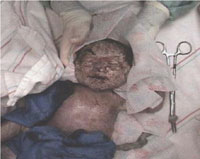Before you start resuscitation
Before you apply any form of resuscitation, make sure that:
- The baby is alive: If the newborn doesn't appear to be alive, FIRST listen to its chest with a stethoscope. If there is no heartbeat, the baby is already dead (see Table 7.1 below).
- You graded the extent of asphyxia: If you can hear a heartbeat, but you estimate it to be less than 60 beats/minute, apply heart massage first, then ventilate alternately on and off, till the heartbeat is above 60 beats/minute (see Table 7.1 below).
- The baby is not deeply meconium stained: If the baby's skin is stained with meconium, or the oral and nasal cavities are filled with meconium-stained fluid (Figure 7.5), you should not resuscitate before suctioning the oral, nasal and pharyngeal areas. Ventilation will aggravate the baby's breathing problem because it will force the meconium-stained fluid deep into the baby's lungs, where it will block the gas exchange.

Figure 7.5 A baby who is not breathing (no signs of chest or nose movement) and with meconium stained all over its body. (Photo: Dr Mulualem Gessese)
Last modified: Monday, 14 July 2014, 4:27 PM